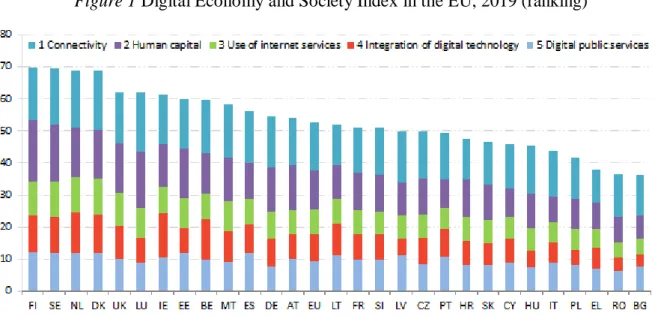The EU in the Global Economy
Online learning
Document identifier
Lesson Title How to proceed? Time need
#10
The EU and the Industry
4.0
1) Video (Intro to Industry 4.0) 2) Reading material
3) Online test
cc. 10 mins.
1
1 I NTRODUCTION
We can say economy has been going through sequential industrial revolution before industry 4.0. General purpose technology including technologies like information communication technology (ICT), electricity with prevalent growth across different sectors for high improvement, making invent of more innovations easier with great effect on the economy.
Industry 4.0 is in close connection with digitalization and artificial intelligence. And it seems that there is a digitalization competition:
the more robots a country use, the more developed it is. It may have risks on the long run, as the notion responsible research and innovation (RRI) draws attention to it.
The European Union also takes part in this process. But we need to analyse: how large the EU’s participation in this process? Is the EU more digitalized than other countries in the world?
Thus, in this lesson we are analysing how the EU can be characterized in the era of digitalization.
Please watch the related video about Industry 4.0
RESPONSIBLE RESEARCH AND
INNOVATION Responsible Research and Innovation as a notion appeared in the beginning of the Millennium. Shortly, it draws attention to the negative impacts and non-expected side- effects of research and innovation. In order to avoid these, researchers and innovators should be more responsible when conducting research. Dan Brown’s books (The Da Vinci Code, Angels and Demons, Origin, etc.) are really good examples when an innovation appears in the hand of a harmful person.
For further details see René von Schomberg- book or the EU’s activity in it:
https://www.rri-tools.eu/about-rri
2
2 D IGITAL E CONOMY AND S OCIETY I NDEX
From the major concern through the decline of industrial sector in the European Union, the EU increases their capacity to fully adapt and take advantage of Industry 4.0. It is expected that four areas will change the manufacturing in the EU: nature, local communities, value chains, and humans. In order to assess the achievement, the EU created the so-called the Digital Economy and Society Index (DESI) that analyze digitalization with five dimensions.
Thus, DESI is a complex indicator measuring the digital performance in the EU. DESI contributes to define intervention areas to achieve the final goal, a truly Digital Single Market.
In 2019, the DESI was the highest in the Northern-European countries: Finland, Sweden, the Netherlands, and Denmark scored the highest ratings (Figure 1). On the other side of the scale stood Romania and Bulgaria. Out of the five dimensions of the DESI, connectivity seems to be the best part, but the majority of the EU countries
really need development in human capital and digital public services.
Connectivity
•Broadband infrastucture
Digital skills
•Skill that a digital society needs
Citizen use of Internet
•Online activities by citizens
Business technology integration
•Digitization in business
Digital public services
•Digitization in public services
Connectivity is the strongest dimension in all EU countries
3 Figure 1 Digital Economy and Society Index in the EU, 2019 (ranking)
Source: European Commission
3 I NTERNATIONAL D IGITAL E CONOMY AND S OCIETY I NDEX – I-DESI
Besides the EU-level DESI, an International Digital Economy and Society Index (I-DESI) also exists. It was firstly published in 2016. I-DESI enables to (1) assess general performance of non-EU countries, too, (2) compare them with the EU countries, and (3) identify the areas that needs improvement. The 2016-standings show that South Korea, Japan and the USA perform much better than the EU countries in average. However, the top 4 EU members perform better than these non-EU countries. All in all, the heterogeneity of the EU members can be recognized here, too.
Figure 2 International Digital Economy and Society overall Index 2016
Source: European Commission
4
4 F URTHER READING
https://ec.europa.eu/digital-single-market/en/desi
https://ec.europa.eu/growth/tools-databases/dem/monitor/category/skills https://ec.europa.eu/growth/tools-
databases/dem/monitor/sites/default/files/Digital%20Transformation%20Scoreboard%202018 _0.pdf
5
